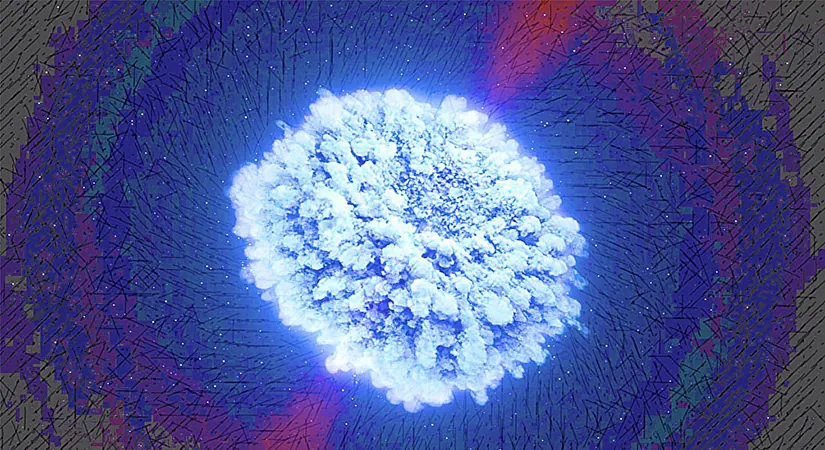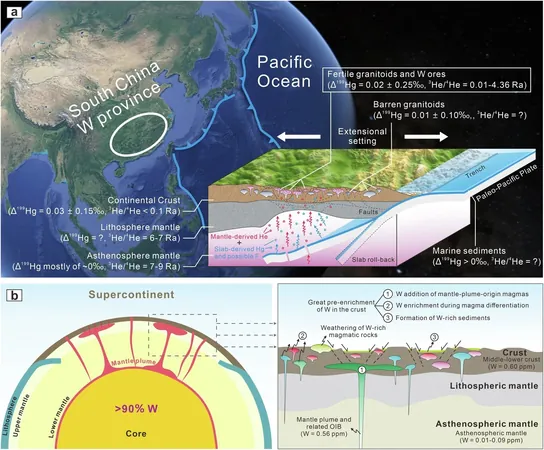
Astrophysicists Capture the Cosmic 'Dance' of Electrons After Neutron Star Collision
2024-10-30
Author: Ming
Astrophysicists have made groundbreaking observations concerning the radioactive glow emitted from the collision of two neutron stars, marking the birth of a black hole. This pivotal discovery enables scientists to measure the intricate microscopic properties of elementary particles involved in these cataclysmic cosmic events for the first time.
A Cosmic Collision Like No Other
The epic collision created the smallest black hole ever recorded and led to an explosion that resulted in a fireball expanding at nearly the speed of light. Over the following days, the explosive event, known as a kilonova, outshone hundreds of millions of suns due to the enormous amount of radiation produced from the decay of heavy elements formed in the aftermath.
An international team of researchers, spearheaded by the Cosmic DAWN Center at the Niels Bohr Institute, collected data from telescopes around the world—leveraging observations from locations as diverse as Australia and South Africa, as well as the iconic Hubble Space Telescope.
“This astrophysical explosion evolves dramatically from hour to hour; no single telescope can capture its entire narrative due to Earth’s rotation. However, by integrating data from different sources, we can unravel the complexities of this event in unprecedented detail,” said Albert Sneppen, a Ph.D. student and lead author of the study.
Echoes of the Big Bang
The temperatures observed immediately after the collision reached staggering levels, soaring into the billions of degrees—thousands of times hotter than the sun’s core. During these extreme conditions, electrons exist in a free state, creating an ionized plasma that resembles the state of the universe mere moments after the Big Bang.
As time progressed, this primordial star-matter cooled, much like the universe did after the Big Bang. Researchers observed distinct evidence of the generation of heavy elements, such as strontium and yttrium, during this cooling phase, indicating the formation of new atoms.
“The striking resemblance to the conditions following the Big Bang underscores the similarity in processes; we can see where atomic nuclei and electrons come together,” explained Rasmus Damgaard, a co-author of the study. “For the first time, we are witnessing the birth of atoms in this cosmic aftermath.”
The Expansive Nature of Cosmic Events
In a remarkable twist, the rapid expansion of the dying star's remnants was so swift that it took hours for light to traverse across the explosion. This means that by observing the distant edges of the fireball, scientists can essentially look back in time to earlier moments of the explosion, revealing a dynamic narrative of cosmic creation.
Kasper Heintz, another co-author and assistant professor at the Niels Bohr Institute, elaborated, “On one side of the black hole’s formation, electrons have merged with atomic nuclei, while the opposite side still represents the early stages of the explosion. This remarkable vantage point allows us to observe the complex interplay of matter as it evolves.”
Implications for Astrophysics
This monumental inquiry into neutron star collisions not only provides insight into the origins of heavy elements but also helps answer long-standing questions in astrophysics regarding element formation in the universe. As researchers continue to unravel these cosmic mysteries, we may be on the brink of understanding how the universe has shaped itself since its inception.
Stay tuned as we delve deeper into the cosmos, exploring the secrets that lie within the stellar phenomena shaping our universe today!




 Brasil (PT)
Brasil (PT)
 Canada (EN)
Canada (EN)
 Chile (ES)
Chile (ES)
 Česko (CS)
Česko (CS)
 대한민국 (KO)
대한민국 (KO)
 España (ES)
España (ES)
 France (FR)
France (FR)
 Hong Kong (EN)
Hong Kong (EN)
 Italia (IT)
Italia (IT)
 日本 (JA)
日本 (JA)
 Magyarország (HU)
Magyarország (HU)
 Norge (NO)
Norge (NO)
 Polska (PL)
Polska (PL)
 Schweiz (DE)
Schweiz (DE)
 Singapore (EN)
Singapore (EN)
 Sverige (SV)
Sverige (SV)
 Suomi (FI)
Suomi (FI)
 Türkiye (TR)
Türkiye (TR)
 الإمارات العربية المتحدة (AR)
الإمارات العربية المتحدة (AR)